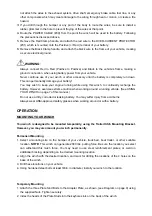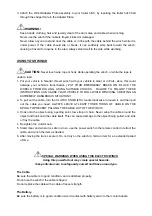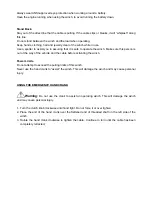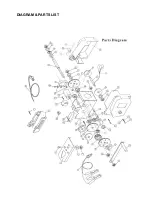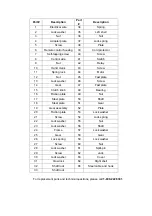
WORK AREA
Keep work area clean,
free of clutter and well lit.
Cluttered and dark work areas can cause
accidents.
Do not use your winch where there is a risk of causing a fire or an explosion;
e.g. in the
presence of flammable liquids, gasses, or dust. Electrically powered tools can create sparks,
which may ignite the dust or fumes.
Keep children and bystanders
away while operating a winch. Distractions can cause you to
lose control, so visitors should remain at a safe distance from the work area.
Be aware of all power lines, electrical circuits,
water pipes and other mechanical hazards in
your work area, particularly those hazards below the work surface hidden from the operator’s
view that may be unintentionally contacted and may cause personal harm or property damage.
Be alert of your surroundings.
Using winches in confined work areas may put you dangerously
close to cutting tools and rotating parts.
PERSONAL SAFETY
Stay alert,
watch what you are doing and use common sense when operating a winch. Do not
use a winch while you are tired or under the influence of drugs, alcohol or medication. A moment
of inattention while operating a winch may result in serious personal injury.
Dress properly.
Do not wear loose clothing, dangling objects, or jewelry. Keep your hair, clothing
and gloves away from moving parts. Loose clothes, jewelry or long hair can be caught in moving
parts. Air vents often cover moving parts and should be avoided.
Use safety apparel and equipment.
Use safety goggles or safety glasses with side shields
which comply with current national standards, or when needed, a face shield. Wear heavy leather
gloves when handling a wire rope. Use as dust mask in dusty work conditions. This applies to all
persons in the work area. Also use non-skid safety shoes, hardhat, gloves, dust collection
systems, and hearing protection when appropriate.
Avoid accidental starting.
Ensure the switch is in the off position before connecting winch into
power supply. In the event of a power failure, while a winch is being used, turn the switch off to
prevent surprise starting when power is restored.
Always
stand clear of wire rope and load during operation, and keep bystanders away as well.
Do not try to guide the cable
Always
be certain the anchor you select will withstand the load, and the strap or chain will not
slip.
Never
use as an overhead hoist, or to suspend a load.
Never
use to lift or move persons.
Never
exceed the winch or wire rope rated capacity.
Never
apply load to hook tip or latch. Apply load to only the center of the hook.
Never
use a hook whose throat opening has increased, or whose tip is bent or twisted.
Never
touch wire rope or hook while in tension or under load.
Never
hook wire rope back onto itself.
Do not apply a load to the winch
when the cable is fully extended. The cable fastener is not
capable of holding the rated capacity.
Do not overreach.
Keep proper footing and balance at all times.
Remove adjusting keys or wrenches
before connecting to the power supply or turning on the
winch. A wrench or key that is left attached to a rotating part of the winch may result in personal
injury.
Summary of Contents for 141220
Page 9: ...DIAGRAM PARTS LIST...






